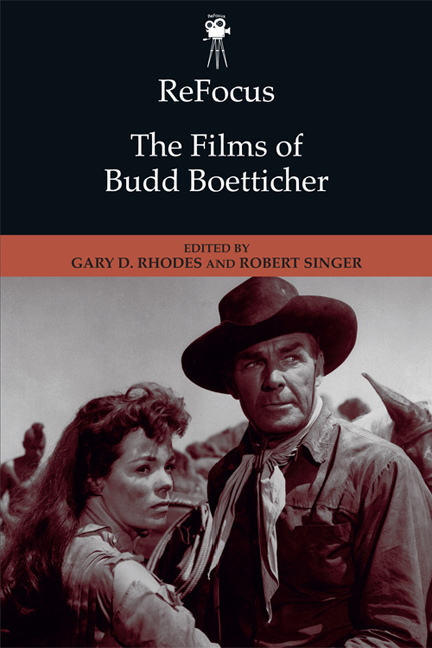Book contents
- Frontmatter
- Contents
- Notes on Contributors
- Dedication
- Introduction
- Part 1 The Non-Westerns
- Part 2 The Westerns
- Part 2 Introduction
- 7 The Ranown Cycle: Budd Boetticher's “New Look” Western Programmers in 1950s Hollywood
- 8 Framings, Motifs, and Floating Poker Games in Seven Men from Now (1956)
- 9 The Ranown Style: Mapping Textual Echoes
- 10 You Were Married, But You Never Had a Wife: The Use of Space in the Westerns of Budd Boetticher
- 11 Ideology and Boetticher's Westerns from the Late 1950s
- 12 Outlaws Without a Cause: Generational Conflict in Budd Boetticher's Ranown Cycle
- 13 The Box in the Desert: Budd Boetticher, Breaking Bad, and the Twenty-first-century Western
- Index
10 - You Were Married, But You Never Had a Wife: The Use of Space in the Westerns of Budd Boetticher
from Part 2 - The Westerns
Published online by Cambridge University Press: 22 December 2017
- Frontmatter
- Contents
- Notes on Contributors
- Dedication
- Introduction
- Part 1 The Non-Westerns
- Part 2 The Westerns
- Part 2 Introduction
- 7 The Ranown Cycle: Budd Boetticher's “New Look” Western Programmers in 1950s Hollywood
- 8 Framings, Motifs, and Floating Poker Games in Seven Men from Now (1956)
- 9 The Ranown Style: Mapping Textual Echoes
- 10 You Were Married, But You Never Had a Wife: The Use of Space in the Westerns of Budd Boetticher
- 11 Ideology and Boetticher's Westerns from the Late 1950s
- 12 Outlaws Without a Cause: Generational Conflict in Budd Boetticher's Ranown Cycle
- 13 The Box in the Desert: Budd Boetticher, Breaking Bad, and the Twenty-first-century Western
- Index
Summary
The first time we see Bart Allison (Randolph Scott) in the opening moments of Budd Boetticher's masterful Western Decision at Sundown (1957), he is already a captive man. There has been no dialogue to lead us at this point in the film nor any movement by characters that would suggest incapacitation, either mental or physical—in fact, Allison is the first person we see in the first shot of the film not associated with the opening credits—but, nonetheless, the viewer understands Allison's position immediately. The emotive and expressive nature of the shot exists outside the realm of narration or story, especially as no story has begun as yet, and resides almost entirely within the specific capacities of the medium. In the credit sequence, we have seen the traveling stagecoach, shot from afar, distancing us from the riders. A shadow placed against a fairly pedestrian “Western sky.” As the coach stops, the camera cuts to a medium shot of Bart Allison who is inside the coach looking out, stone faced as usual for Randolph Scott. What is immediately noticeable is that he is caught in a frame within the frame. The window frame of the coach acts as a manner of cage, barring Allison from the outside world. Inside the coach is dark with Allison peering out into the bright, sun-washed day. In some regards, it works in contrast to the famous final shot in John Ford's The Searchers (1956). In that film the darkness is the civilized world that John Wayne's Ethan Edwards can no longer inhabit whereas, in the opening to Decision at Sundown, Bart Allison is kept captive in the darkness, while the bright “civilized world” is something to be peered at.
The ultimate purpose of this description, and the primary focus of this chapter, is to explore how Budd Boetticher utilized the formal capacities of his medium to express emotion and meaning. Boetticher did not make complicated Westerns when compared to the likes of John Ford or Anthony Mann. This is particularly true from the perspective of their stories. One can neatly map nearly every major Budd Boetticher Western: lone male hero, searching to reclaim his wronged or dead wife's honor; along the way he helps another man regain his honor; cut to final shootout.
- Type
- Chapter
- Information
- ReFocus: The Films of Budd Boetticher , pp. 166 - 187Publisher: Edinburgh University PressPrint publication year: 2017



